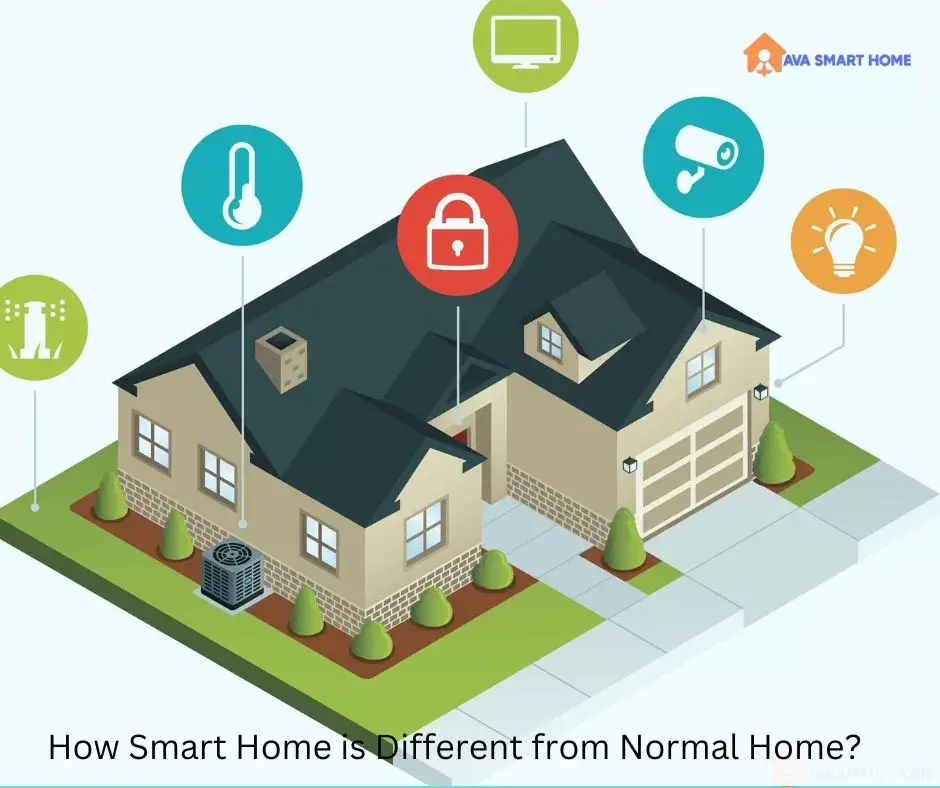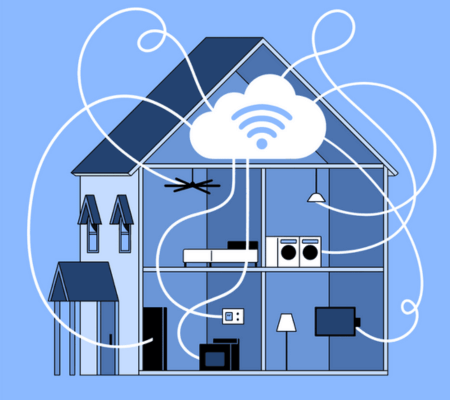Smart homes have become increasingly popular in recent years due to the convenience and efficiency they offer. A smart home is a residence that uses internet-connected devices to enable the remote monitoring and management of appliances and systems, such as lighting and heating. In contrast, a normal home does not have these features and relies on manual control of these systems.

One of the key differences between a smart home and a normal home is the level of control and automation available. Smart home technology enables homeowners to control many different aspects of their homes remotely. This includes lighting, climate control, entertainment systems, security systems, and other appliances. With a smart home, homeowners can use their smartphones, tablets, or voice assistants to adjust settings and monitor their homes from anywhere in the world.
Choose: 10 Easy Smart Home Essentials for Renters
Another advantage of smart homes is saving energy and reducing costs. Smart thermostats, for example, can learn the homeowner’s preferences and adjust the temperature accordingly, leading to significant energy savings. Additionally, smart lighting systems can be programmed to turn off when not in use, reducing energy consumption and lowering electricity bills. Overall, smart homes offer a range of benefits, making them an attractive option for homeowners looking to improve their quality of life.
Why Smart Homes?
Smart homes are houses that use technology to automate and simplify daily tasks. They are different from normal homes because they have integrated technology, remote accessibility, and energy efficiency.
Integrated Technology
Smart homes have integrated technology that allows homeowners to control many different aspects of their homes remotely. This includes lighting, climate control, entertainment, security, and other appliances. With the help of sensors and devices, smart homes can automatically adjust the temperature, turn off lights when no one is in the room, and even lock the doors when the homeowner leaves.
Related: 15 Best Smart Plugs for Google Home
Smart homes also can learn the habits of the homeowner and adjust accordingly. For example, if the homeowner always turns on the lights when they come home from work, the smart home system can learn this behavior and automatically turn them on when the homeowner arrives.
Remote Accessibility
Another key difference between smart homes and normal homes is remote accessibility. Smart homes allow homeowners to control their homes from anywhere in the world using their smartphones, tablets, or computers. This means that homeowners can adjust the temperature, turn off lights, and even lock the doors from their office or while on vacation.
Smart home systems also allow for remote monitoring of the home. Homeowners can receive alerts if there is a security breach, a water leak, or if the smoke detector goes off. This gives homeowners peace of mind, knowing that their home is secure and protected even when they are not there.
Energy Efficiency
Smart homes are also more energy efficient than normal homes. They use sensors and devices to automatically adjust the temperature and turn off lights when no one is in the room. This helps to reduce energy waste and lower utility bills.
Related: Top 5 Best Smart Thermostats That Work With Alexa in 2024
Smart homes also can track energy usage and provide homeowners with insights into their energy consumption. This allows homeowners to make more informed decisions about their energy usage and make changes to reduce their carbon footprint.
In summary, smart homes differ from normal homes because they have integrated technology, remote accessibility, and energy efficiency. They allow homeowners to control their homes from anywhere worldwide and are more energy efficient than traditional homes.
Compared with Normal Homes
Smart homes have emerged as a popular choice for homeowners in recent years. They offer a range of benefits that normal homes do not. Here are some of the key differences between smart homes and normal homes:
Convenience Differences
One of the most significant differences between smart homes and normal homes is their convenience level. Smart homes come equipped with various devices and systems that allow homeowners to remotely control different aspects of their homes. This includes lighting, climate control, entertainment, security, and other appliances. With a smart home, homeowners can control these systems using a smartphone or tablet, even when they are away from home.
In contrast, normal homes require homeowners to control these systems manually. For example, if a homeowner wants to turn on the lights, they must walk over to the light switch and flip it on. Similarly, if they want to adjust the temperature, they need to go to the thermostat and make the necessary adjustments.
Security Differences
Another significant difference between smart homes and normal homes is their security level. Smart homes come equipped with various security systems and devices that allow homeowners to monitor their homes remotely. This includes security cameras, motion sensors, and smart locks. With a smart home, homeowners can receive alerts on their smartphone if there is any unusual activity in or around their home.
Choose: Enhance Surveillance with the Best 4K PTZ Security Camera: Ultimate Guide and Reviews
In contrast, normal homes typically do not have these security features. Homeowners need to rely on traditional security measures such as locks and alarms to keep their homes secure.
Cost Differences
Smart homes can be more expensive than normal homes. The cost of installing smart devices and systems can be high, and homeowners may need to pay for ongoing maintenance and upgrades. However, smart homes can also save homeowners money in the long run by reducing energy costs and improving home security.
Normal homes, on the other hand, maybe less expensive to purchase and maintain. However, homeowners may need to pay higher energy bills and may not have the same level of convenience and security as smart homes.
Overall, smart homes offer a range of benefits that normal homes do not. From increased convenience to improved security, smart homes are popular for homeowners looking to upgrade their living space.










